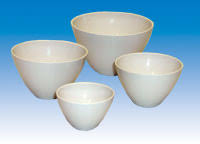Loss on Ignition
Purpose and Limitations
Loss on ignition is an experiment conducted in order to learn how much of a soil sample is composed of organic matter. Organic matter in this case can be water or carbonate minerals [4], among other things. After the ignition phase of the test, the measured mass should provide an accurate estimate of how much organic matter was lost during the ignition, leaving solely the compositional materials of the soil (i.e. sand, gravel). The data collected from these experiments can be used to develop soil profiles for the areas the samples are collected from. This can be useful for agriculture, development, or environmental protection and rehabilitation strategies.
In comparison to other tests done to determine the organic matter content of soil samples, the loss on ignition test is relatively simple and inexpensive. There is no need for the use of chemicals or advanced equipment - one just needs access to a muffle furnace. Despite these positives, the loss on ignition method of testing for organic matter does have some limitations. One must be careful to perform the experiment at the correct temperature, or there will be risk of losing certain volatile salts, structural water and inorganic carbon [1], which can skew the results. In addition, depending on what type of sample one is testing, there must be acknowledgment that loss on ignition testing being used to estimate unburned carbon in combustion residues does not yield accurately data [5].
Equipment
The equipment required to perform the loss on ignition test is relatively limited, although one does need access to a laboratory setting that contains a muffle furnace. The equipment needed is as follows [4]:
1) Ceramic crucibles.

2) Sampling device, such as a spatula or syringe.
3) Muffle furnace capable of reaching 1000 degrees Celsius.

4) Balance weighing in grams to 4 decimal places.
5) Sample that is going to be tested.
6) High temperature tongs or gloves.
Steps
Just as the equipment is, the steps to performing the test are relatively simple [4]:
1) Furnace safe containers are weighed for their starting weights and those numbers are recorded.
2) Samples are added to the crucibles and weighed, with those weights being recorded.
3) Subtract the starting container weight from the weight of the container plus the sample number to get the weight of just the samples alone.
4) Place your samples in the muffle furnace. Be careful to not pre-heat the furnace as the heat shock will cause the crucibles to explode.
5) Leave your samples in the muffle furnace overnight (at least 24 hours).
6) The next day, turn the furnace off and allow it to cool completely before removing your samples.
7) Weigh the samples again, subtracting the previously gathered weighs of the crucibles alone from the results. This number is the amount of sample weight you have. Compare this number to the weights of your samples before the test.
8) Repeat steps above as necessary to improve accuracy.
References
1) Oliver Heiri, A. F. L., and Gerry Lemcke, 2001, Journal of Paleolimnology, v. 25, no. 1, p. 101-110.
2) 864in³ Muffle Furnace w/ Digital Controller - Gilson Co.: https://www.globalgilson.com/864in-muffle-furnace-w-digital-controller, p. Image.
3) Crucible, Ceramic Crucible, 150 ml: https://www.atlanticsupply.com/product/crucible-150-ml-ceramic-crucible/, p. Photo.
4) LacCore, N. L. C. F., 2013, Loss-on-Iginition Standard Operating Procedure: University of Minnesota.
5) Loss on Ignition (LOI) of Solid Combustion Residues: Purdue Univeristy, ASTM International.